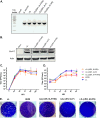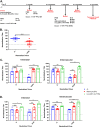Immunogenicity of Mumps Virus Genotype G Vaccine Candidates in Jeryl Lynn-Immunized Mice
- PMID: 35389265
- PMCID: PMC9044963
- DOI: 10.1128/jvi.01983-21
Immunogenicity of Mumps Virus Genotype G Vaccine Candidates in Jeryl Lynn-Immunized Mice
Abstract
Mumps virus (MuV) causes a highly contagious human disease characterized by the enlargement of the parotid glands. In severe cases, mumps can lead to neurological complications such as aseptic meningitis and encephalitis. Vaccination with the attenuated Jeryl Lynn (JL) MuV vaccine has dramatically reduced the incidence of MuV infection. Recently, large outbreaks have occurred in vaccinated populations. The vaccine strain JL was generated from genotype A, while most current circulating strains belong to genotype G. In this study, we examined the immunogenicity and longevity of genotype G-based vaccines. We found that our recombinant genotype G-based vaccines provide robust neutralizing titers toward genotype G for up to 1 year in mice. In addition, we demonstrated that a third dose of a genotype G-based vaccine following two doses of JL immunization significantly increases neutralizing titers toward the genotype G strain. Our data suggest that after two doses of JL vaccination, which most people have received, a third dose of a genotype G-based vaccine can generate immunity against a genotype G strain. IMPORTANCE At present, most individuals have received two doses of the measles, mumps, and rubella (MMR) vaccine, which contains genotype A mumps vaccine. One hurdle in developing a new mumps vaccine against circulating genotype G virus is whether the new genotype G vaccine can generate immunity in humans that are immunized against genotype A virus. This work demonstrates that a novel genotype G-based vaccine can be effective in animals which received two doses of genotype A-based vaccine, suggesting that the lead genotype G vaccine may induce anti-G immunity in humans who have received two doses of the current vaccine, providing support for testing this vaccine in humans.
Keywords: Jeryl Lynn; mumps vaccine.
Conflict of interest statement
The authors declare a conflict of interest. BH is an inventor of patent “recombinant mumps vaccines” which is owned by the University of Georgia Research Foundation (UGARF). BH is a founder and share holder of a company that licensed the patent from UGARF to develop a mumps vaccine.
Figures







Similar articles
-
Immunogenicity of mumps virus vaccine candidates matching circulating genotypes in the United States and China.Vaccine. 2017 Jul 13;35(32):3988-3994. doi: 10.1016/j.vaccine.2017.05.084. Epub 2017 Jun 13. Vaccine. 2017. PMID: 28623030 Free PMC article.
-
Vaccines for measles, mumps, rubella, and varicella in children.Cochrane Database Syst Rev. 2020 Apr 20;4(4):CD004407. doi: 10.1002/14651858.CD004407.pub4. Cochrane Database Syst Rev. 2020. Update in: Cochrane Database Syst Rev. 2021 Nov 22;11:CD004407. doi: 10.1002/14651858.CD004407.pub5. PMID: 32309885 Free PMC article. Updated.
-
Mumps-specific cross-neutralization by MMR vaccine-induced antibodies predicts protection against mumps virus infection.Vaccine. 2016 Jul 29;34(35):4166-4171. doi: 10.1016/j.vaccine.2016.06.063. Epub 2016 Jun 29. Vaccine. 2016. PMID: 27372154
-
Mumps: MMR vaccination and genetic diversity of mumps virus, 2007-2011 in Catalonia, Spain.BMC Infect Dis. 2019 Nov 9;19(1):954. doi: 10.1186/s12879-019-4496-z. BMC Infect Dis. 2019. PMID: 31706275 Free PMC article.
-
Measles, mumps, rubella vaccine (Priorix; GSK-MMR): a review of its use in the prevention of measles, mumps and rubella.Drugs. 2003;63(19):2107-26. doi: 10.2165/00003495-200363190-00012. Drugs. 2003. PMID: 12962524 Review.
Cited by
-
Booster doses of an inactivated F genotype mumps vaccine enhance immunogenicity in mice.Vaccine X. 2024 Jan 13;17:100437. doi: 10.1016/j.jvacx.2024.100437. eCollection 2024 Mar. Vaccine X. 2024. PMID: 38317857 Free PMC article.
-
Immunogenicity and Cross-Protection Efficacy of a Genotype F-Derived Attenuated Virus Vaccine Candidate against Mumps Virus in Mice.Vaccines (Basel). 2024 May 30;12(6):595. doi: 10.3390/vaccines12060595. Vaccines (Basel). 2024. PMID: 38932324 Free PMC article.
References
-
- CDC. 26 April 2019. Mumps cases and outbreaks. National Center for Immunization and Respiratory Diseases, Division of Viral Diseases, Centers for Disease Control and Prevention. https://www.cdc.gov/mumps/outbreaks.html.
MeSH terms
Substances
LinkOut - more resources
Full Text Sources
Medical

